Abstract
Isogenic variants of antibiotic-resistant and -sensitive Neisseria gonorrhoeae were examined for differences in the inhibition of oxygen uptake by steroid hormones. Mutants designated as env, which possessed cell envelope mutations allowing phenotypic suppression of low-level antibiotic resistance, were more sensitive to steroid hormone inhibition of oxygen uptake than the wild-type parental strains. Possession of an mtr locus, which confers nonspecific resistance to multiple antibiotics, dyes, and detergents, was also associated with an increase in resistance to steroid hormone inhibition of oxygen uptake. The penA2 locus, which confers an eightfold increase in resistance to penicillin, was not responsible for the increased resistance to steroid hormones. Phospholipids in the outer membrane of intact env-2 cells were susceptible to digestion by phospholipase C, indicating exposure of phospholipid head groups on the outer surface. Cells of a wild-type and mtr-2 strain were not susceptible to phospholipase C digestion unless they were pretreated with mixed exoglycosidases. This pretreatment also increased the sensitivity of mtr-2 cells to progesterone inhibition of O2 uptake. These data suggest that the permeability of the gonococcus to hydrophobic antibiotic and steroid molecules is mediated by the degree of phospholipid exposure on the outer membrane.
Full text
PDF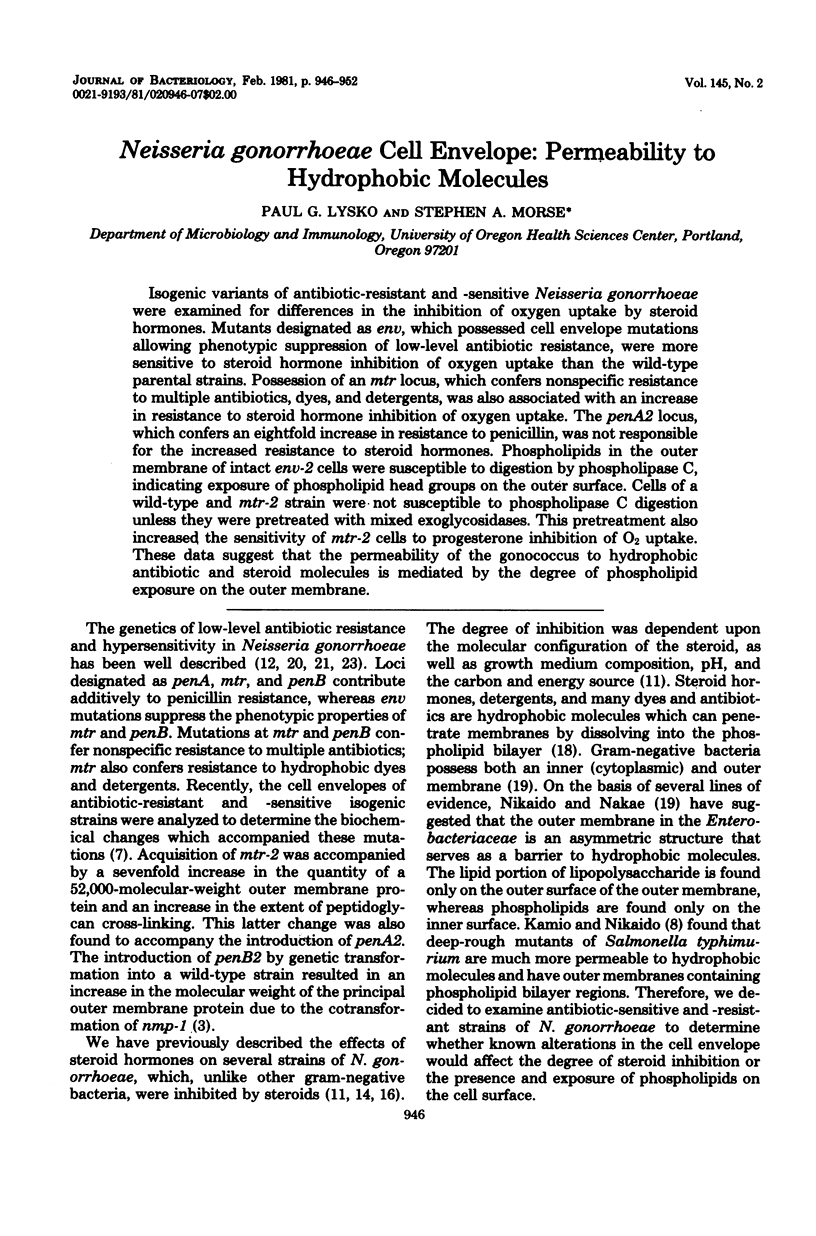
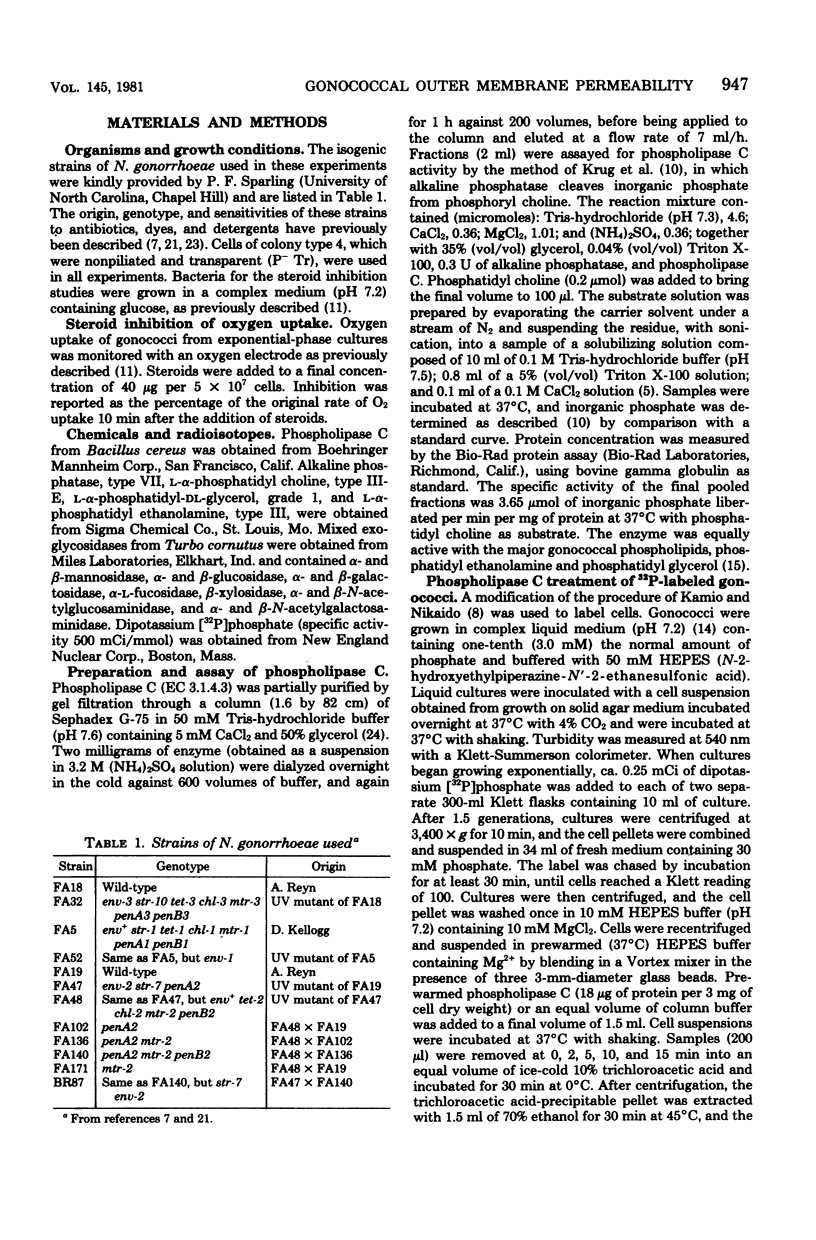
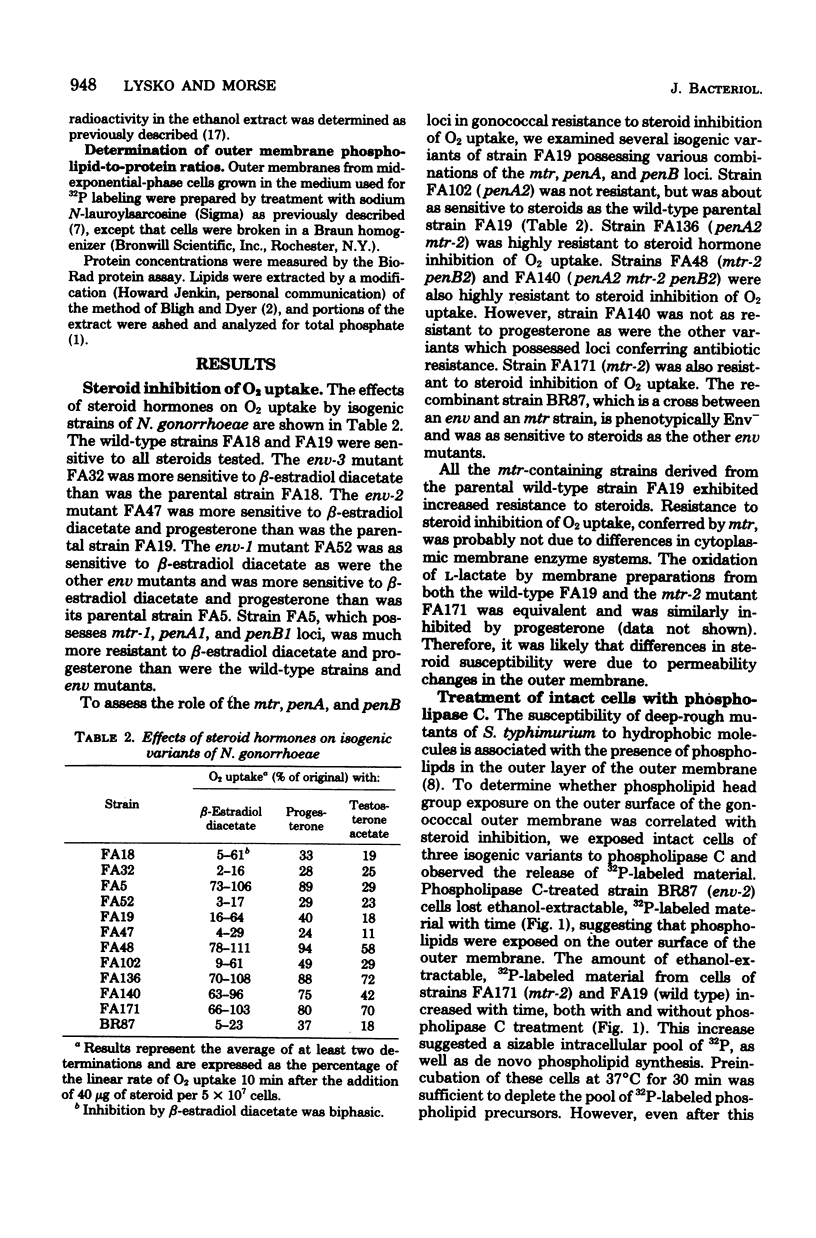
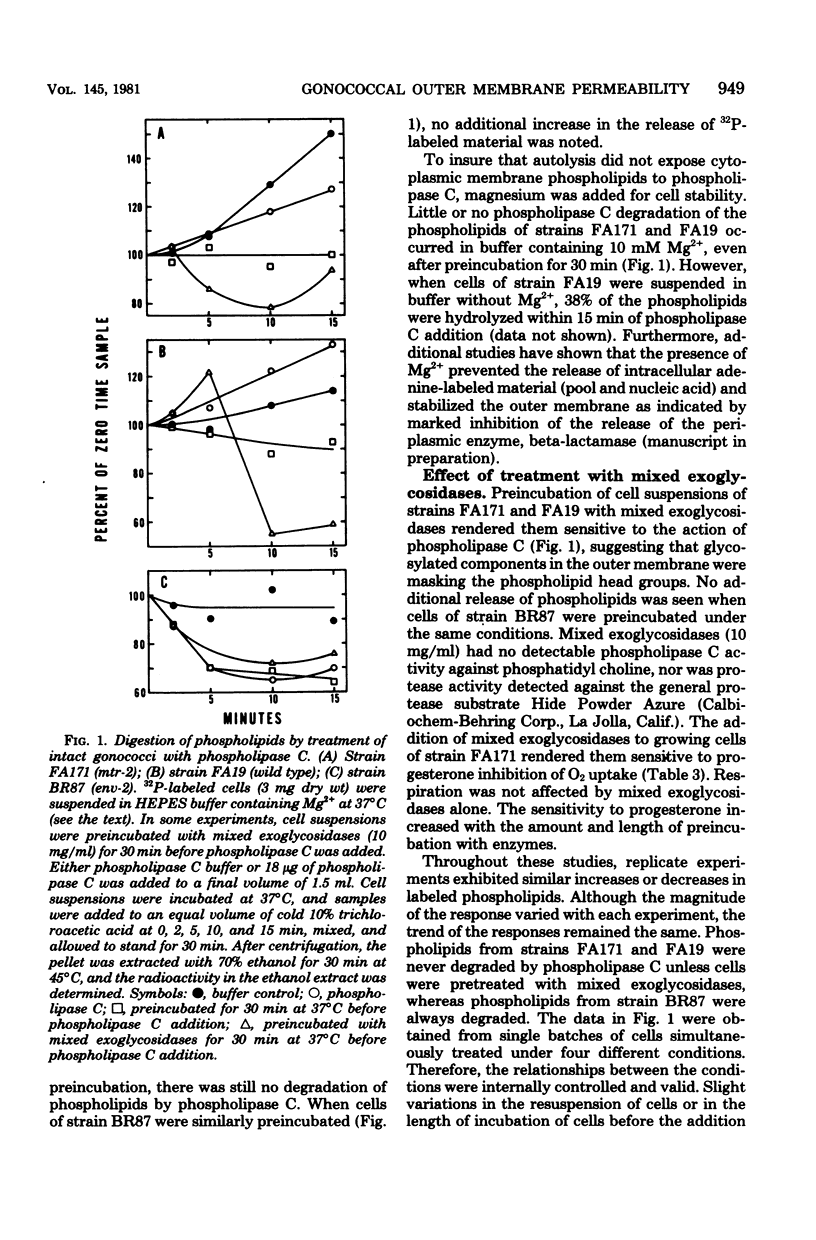
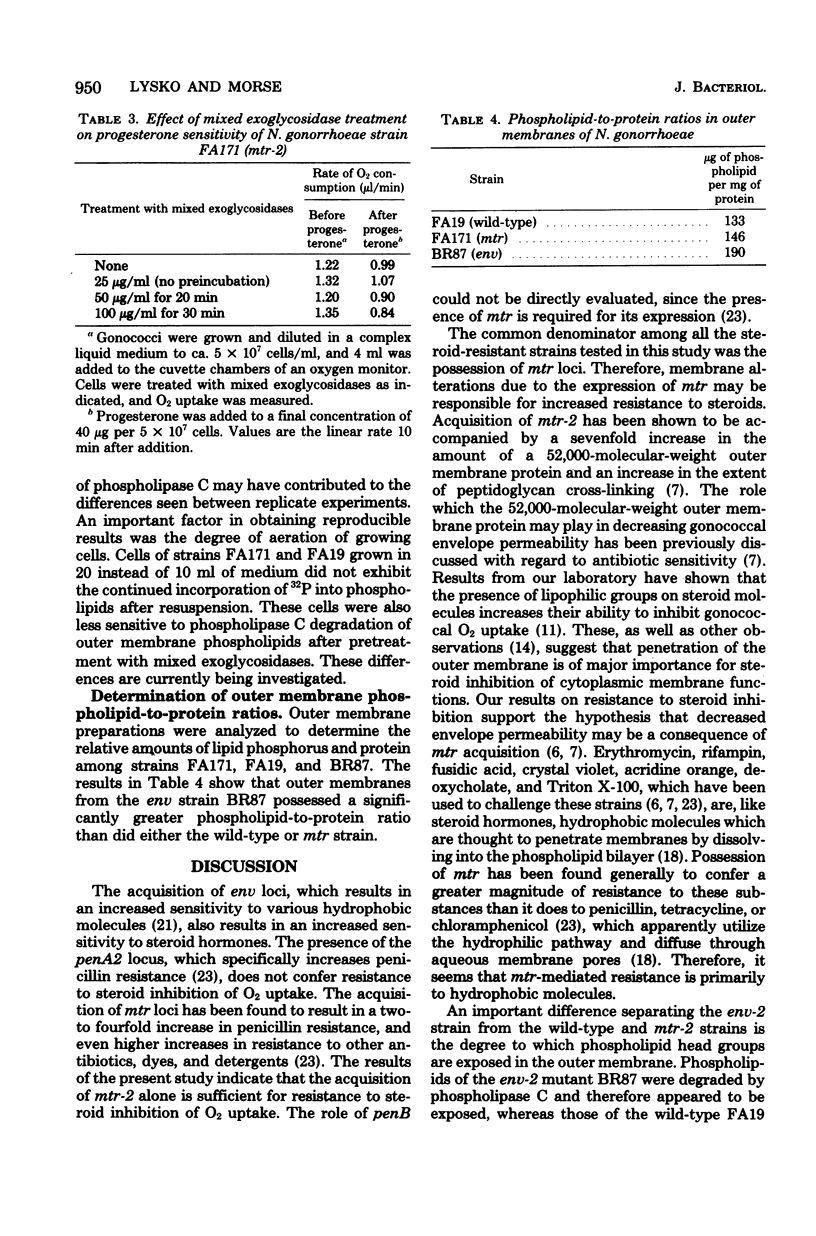
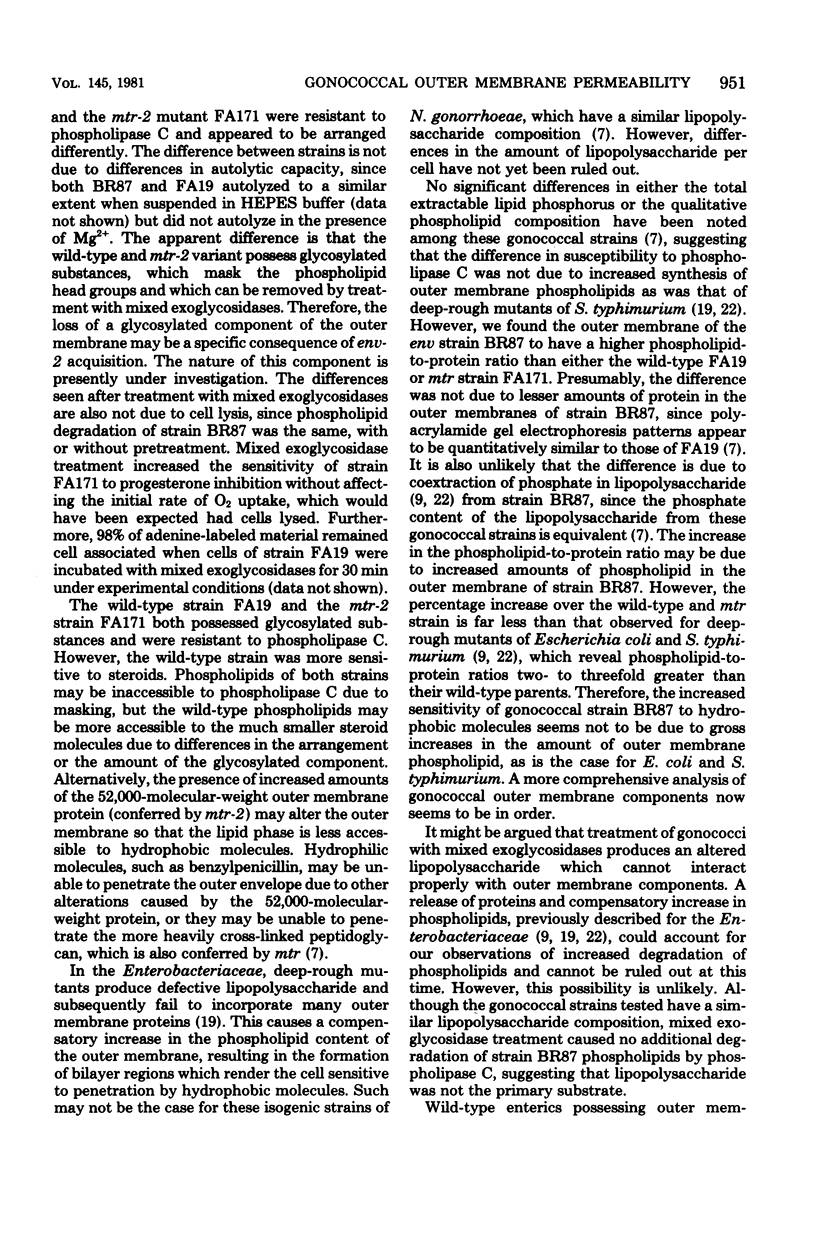
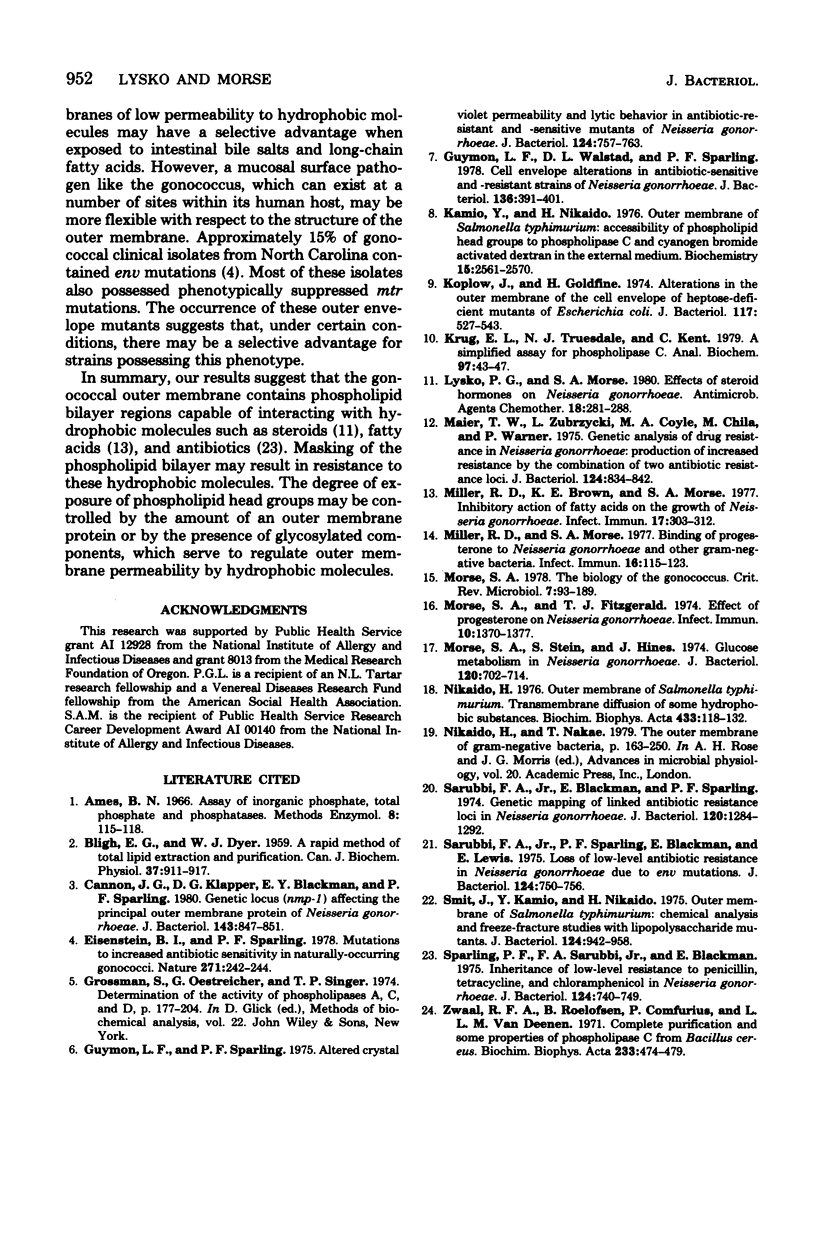
Selected References
These references are in PubMed. This may not be the complete list of references from this article.
- BLIGH E. G., DYER W. J. A rapid method of total lipid extraction and purification. Can J Biochem Physiol. 1959 Aug;37(8):911–917. doi: 10.1139/o59-099. [DOI] [PubMed] [Google Scholar]
- Cannon J. G., Klapper D. G., Blackman E. Y., Sparling P. F. Genetic locus (nmp-1) affecting the principal outer membrane protein of Neisseria gonorrhoeae. J Bacteriol. 1980 Aug;143(2):847–851. doi: 10.1128/jb.143.2.847-851.1980. [DOI] [PMC free article] [PubMed] [Google Scholar]
- Eisenstein B. I., Sparling P. F. Mutations to increased antibiotic sensitivity in naturally-occurring gonococci. Nature. 1978 Jan 19;271(5642):242–244. doi: 10.1038/271242a0. [DOI] [PubMed] [Google Scholar]
- Grossman S., Oestreicher G., Singer T. P. Determination of the activity of phospholipases A, C, and D. Methods Biochem Anal. 1974;22:177–204. doi: 10.1002/9780470110423.ch4. [DOI] [PubMed] [Google Scholar]
- Guymon L. F., Sparling P. F. Altered crystal violet permeability and lytic behavior in antibiotic-resistant and -sensitive mutants of Neisseria gonorrhoeae. J Bacteriol. 1975 Nov;124(2):757–763. doi: 10.1128/jb.124.2.757-763.1975. [DOI] [PMC free article] [PubMed] [Google Scholar]
- Guymon L. F., Walstad D. L., Sparling P. F. Cell envelope alterations in antibiotic-sensitive and-resistant strains of Neisseria gonorrhoeae. J Bacteriol. 1978 Oct;136(1):391–401. doi: 10.1128/jb.136.1.391-401.1978. [DOI] [PMC free article] [PubMed] [Google Scholar]
- Kamio Y., Nikaido H. Outer membrane of Salmonella typhimurium: accessibility of phospholipid head groups to phospholipase c and cyanogen bromide activated dextran in the external medium. Biochemistry. 1976 Jun 15;15(12):2561–2570. doi: 10.1021/bi00657a012. [DOI] [PubMed] [Google Scholar]
- Koplow J., Goldfine H. Alterations in the outer membrane of the cell envelope of heptose-deficient mutants of Escherichia coli. J Bacteriol. 1974 Feb;117(2):527–543. doi: 10.1128/jb.117.2.527-543.1974. [DOI] [PMC free article] [PubMed] [Google Scholar]
- Krug E. L., Truesdale N. J., Kent C. A simplified assay for phospholipase C. Anal Biochem. 1979 Aug;97(1):43–47. doi: 10.1016/0003-2697(79)90324-5. [DOI] [PubMed] [Google Scholar]
- Lysko P. G., Morse S. A. Effects of steroid hormones on Neisseria gonorrhoeae. Antimicrob Agents Chemother. 1980 Aug;18(2):281–288. doi: 10.1128/aac.18.2.281. [DOI] [PMC free article] [PubMed] [Google Scholar]
- Maier T. W., Zubrzycki L., Coyle M. B., Chila M., Warner P. Genetic analysis of drug resistance in Neisseria gonorrhoeae: production of increased resistance by the combination of two antibiotic resistance loci. J Bacteriol. 1975 Nov;124(2):834–842. doi: 10.1128/jb.124.2.834-842.1975. [DOI] [PMC free article] [PubMed] [Google Scholar]
- Miller R. D., Brown K. E., Morse S. A. Inhibitory action of fatty acids on the growth of Neisseria gonorrhoeae. Infect Immun. 1977 Aug;17(2):303–312. doi: 10.1128/iai.17.2.303-312.1977. [DOI] [PMC free article] [PubMed] [Google Scholar]
- Miller R. D., Morse S. A. Binding of progesterone to Neisseria gonorrhoeae and other gram-negative bacteria. Infect Immun. 1977 Apr;16(1):115–123. doi: 10.1128/iai.16.1.115-123.1977. [DOI] [PMC free article] [PubMed] [Google Scholar]
- Morse S. A., Fitzgerald T. J. Effect of progesterone on Neisseria gonorrhoeae. Infect Immun. 1974 Dec;10(6):1370–1377. doi: 10.1128/iai.10.6.1370-1377.1974. [DOI] [PMC free article] [PubMed] [Google Scholar]
- Morse S. A., Stein S., Hines J. Glucose metabolism in Neisseria gonorrhoeae. J Bacteriol. 1974 Nov;120(2):702–714. doi: 10.1128/jb.120.2.702-714.1974. [DOI] [PMC free article] [PubMed] [Google Scholar]
- Morse S. A. The biology of the gonococcus. CRC Crit Rev Microbiol. 1978;7(2):93–189. doi: 10.3109/10408417909083071. [DOI] [PubMed] [Google Scholar]
- Nikaido H., Nakae T. The outer membrane of Gram-negative bacteria. Adv Microb Physiol. 1979;20:163–250. doi: 10.1016/s0065-2911(08)60208-8. [DOI] [PubMed] [Google Scholar]
- Nikaido H. Outer membrane of Salmonella typhimurium. Transmembrane diffusion of some hydrophobic substances. Biochim Biophys Acta. 1976 Apr 16;433(1):118–132. doi: 10.1016/0005-2736(76)90182-6. [DOI] [PubMed] [Google Scholar]
- Sarubbi F. A., Jr, Blackman E., Sparling P. F. Genetic mapping of linked antibiotic resistance loci in Neisseria gonorrhoeae. J Bacteriol. 1974 Dec;120(3):1284–1292. doi: 10.1128/jb.120.3.1284-1292.1974. [DOI] [PMC free article] [PubMed] [Google Scholar]
- Sarubbi F. A., Jr, Sparling P. F., Blackman E., Lewis E. Loss of low-level antibiotic resistance in Neisseria gonorrhoeae due to env mutations. J Bacteriol. 1975 Nov;124(2):750–756. doi: 10.1128/jb.124.2.750-756.1975. [DOI] [PMC free article] [PubMed] [Google Scholar]
- Smit J., Kamio Y., Nikaido H. Outer membrane of Salmonella typhimurium: chemical analysis and freeze-fracture studies with lipopolysaccharide mutants. J Bacteriol. 1975 Nov;124(2):942–958. doi: 10.1128/jb.124.2.942-958.1975. [DOI] [PMC free article] [PubMed] [Google Scholar]
- Sparling P. F., Sarubbi F. A., Jr, Blackman E. Inheritance of low-level resistance to penicillin, tetracycline, and chloramphenicol in Neisseria gonorrhoeae. J Bacteriol. 1975 Nov;124(2):740–749. doi: 10.1128/jb.124.2.740-749.1975. [DOI] [PMC free article] [PubMed] [Google Scholar]
- Zwaal R. F., Roelofsen B., Comfurius P., van Deenen L. L. Complete purification and some properties of phospholipase C from Bacillus cereus. Biochim Biophys Acta. 1971 Apr 13;233(2):474–479. doi: 10.1016/0005-2736(71)90347-6. [DOI] [PubMed] [Google Scholar]


